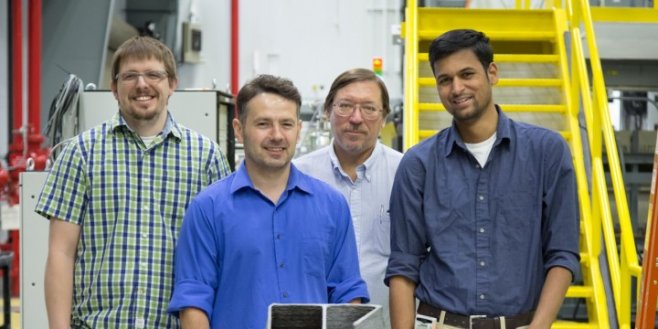Copyright 2012 neutronsources.org | All rights reserved. | Powered by FRM II | Imprint / Privacy Policy
Neutron scattering impacts daily life

Researchers from the DOE Manufacturing Demonstration Facility located at ORNL used neutrons to test residual stress in 3D-printed steel parts. By studying complex geometries like the figure 6 shown here, researchers can design and build more complex structures with large-scale 3D metal printing. Pictured from left, Jeffrey Bunn, Andrzej Nycz, Mark Noakes, and Niyanth Sridharan.
At Oak Ridge National Laboratory (ORNL), the nation’s premier neutron scattering facilities enable a wide spectrum of research across disciplines that intersect with everyday life. Neutrons are an exceptional resource for probing the atomic properties of materials, leading to advancements in materials science, biology, chemistry, and physics—and bringing us more effective drugs and medical treatments, 3D-printed tools and machinery, biofuels, and better batteries and energy storage technologies. Neutron-based research at the High-Flux Isotope Reactor and the Spallation Neutron Source drives these real-world impacts as each year thousands of researchers from universities and industry worldwide come to these facilities to conduct free open research that answers fundamental questions about the structure and behavior of matter in the universe.
Next-generation 3D printing
Additive manufacturing or 3D printing has produced a remarkable list of firsts in 3D-printed structures, including automobiles, submersibles, and construction equipment. Now, neutrons are leading to new capabilities for 3D printing of large-scale metal structural components like the excavator arm printed at the US Department of Energy’s Manufacturing Demonstration Facility (MDF) at ORNL, as well as dies and molds to speed up production of tooling for US industry. At the High Flux Isotope Reactor’s HB-2B Neutron Residual Stress Mapping Facility, researchers from MDF used neutrons to better understand the stresses materials like steel undergo during the printing process. “Our three-dimensional test piece, shaped like a figure 6, allows us to examine distinct geometrical features and measure what the stresses might be in those so we can design and build new 3D-printed structures,” said Mark Noakes of the Manufacturing Systems Research group. Using computational models to predict the behavior of 3D-printed parts in service is a new frontier for additive manufacturing, says ORNL postdoc Niyanth Sridharan. “The first step is to develop and validate models that can then be leveraged by end users to ensure the performance of additively manufactured parts in real-world applications,” said Sridharan.
Advancements in energy storage
With a goal to design new materials that can capture and store hydrogen for energy applications, researchers are hoping to capitalize on the discovery that hydrogen’s bonding strength increases in a high-pressure environment. “New materials that can store hydrogen in greater density are candidates for clean burning hydrogen fuel vehicles, for example. More hydrogen capacity means being able to drive for longer distances,” said Timothy Strobel of the Geophysical Laboratory for the Carnegie Institute for Science. Neutrons are uniquely suited for studying light elements, like hydrogen, that are not easily detected by other experimental methods such as x-rays, but the tools and equipment for high-pressure studies with neutrons have to be developed first. Strobel sought the expertise of Reinhard Boehler, jointly of ORNL and Carnegie, who designed a tool to study hydrogen under high pressure with neutron scattering. With the one-of-a-kind rig on the Spallation Neutron Source’s VISION spectrometer, Strobel’s team is learning just how much energy transfer happens to pressurized samples. Beyond hydrogen, the gas-loading vessel, rated at 3,000 times atmospheric pressure, can be used for other high-pressure studies, enabling new capabilities—and new science—with neutrons.
New medical treatments
Yu Zhao, a graduate student from Pennsylvania State University’s Department of Food Science, used the High Flux Isotope Reactor’s HB-2C WAND instrument to study the interactions of antioxidants with cell membranes. Antioxidants help stave off age-related diseases like Alzheimer’s, but the body’s ability to absorb antioxidants from foods like fruits and vegetables is relatively low, Zhao explained. Zhao used neutron scattering to detect antioxidants in sunflower lecithin, used in biological experiments to mimic real cell membranes. WAND’s lead instrument scientist, Matthias Frontzek, explained that WAND is well-suited to Zhao’s experiment. Frontzek worked with ORNL Biology and Soft Matter Division’s Drew Marquardt to optimize WAND for studying the delicate lipid bilayers that make up cell membranes. “Our sample chamber is custom built for biological experiments like Zhao’s. We accurately control the temperature of the sample, and we hydrate it with salt solutions to very specific humidities so we can fine-tune our experiments to mimic the conditions existing on the surface of cell membranes,” said Frontzek. Zhao said neutrons are ideal for his research: “They can help me find the exact location of antioxidants in cell membranes and provide insights into their mechanisms of penetration.” The results, he explained, could help guide development of more effective antioxidant therapies for Alzheimer’s, Parkinson’s, and related diseases and disorders.
The US Department of Energy (DOE) Office of Energy Efficiency and Renewable Energy Advanced Manufacturing Office (AMO) supports the Manufacturing Demonstration Facility at ORNL. AMO supports early stage applied research and development of new materials, information, and processes that improve American manufacturing’s energy efficiency, as well as platform technologies for manufacturing clean energy products.
The High Flux Isotope Reactor and Spallation Neutron Source are DOE Office of Science User Facilities. UT-Battelle manages ORNL for the DOE Office of Science. The single largest supporter of basic research in the physical sciences in the United States, the Office of Science is working to address some of the most pressing challenges of our time. For more information, please visit science.energy.gov.—by Ashley Huff.

New equipment developed to study hydrogen is leading to a new frontier for neutron scattering research under high-pressure conditions.

Penn State graduate student Yu Zhao used neutrons to study the behavior of antioxidants in cell membranes to gain insights that could help fight diseases like Alzheimer’s and Parkinson’s.
October 17, 2017